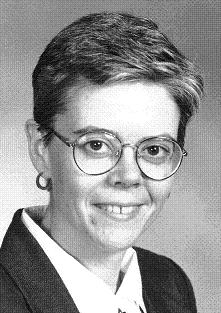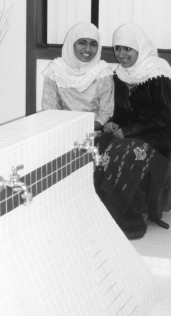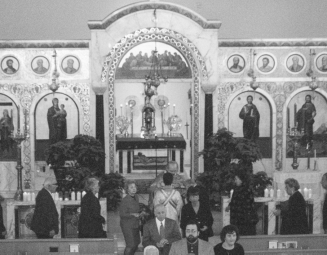Sheila E. McGinn, John Carroll University
 Sheila E. McGinn is Professor of Biblical Studies and Early Christianity at John Carroll University. Her publications include The Montanist Oracles, The Acts of Thecla, studies of Paul’s letter to the Romans, a commentary on the Gospel of Matthew, and a bibliography of twentieth century research into the Book of Revelation. Sheila E. McGinn is Professor of Biblical Studies and Early Christianity at John Carroll University. Her publications include The Montanist Oracles, The Acts of Thecla, studies of Paul’s letter to the Romans, a commentary on the Gospel of Matthew, and a bibliography of twentieth century research into the Book of Revelation.
I have used field research as an integral part of my “Introduction to Religious Studies” course for over a decade. Three students are in each research group, and the project includes several components, with at least one site visit. The description of the assignment is as follows:
Field Research Project
Student groups engage in a three-part Field Research Project on one of the five major world religions, focusing either on an unfamiliar religious tradition or an unfamiliar ethnic community within their own religious tradition. The three parts include:
- Library research regarding the tradition’s beliefs, ethics, and ritual practices;
- Observation of a religious ritual in that tradition; and
- At least one interview with a minister or other leader of this religious community regarding the tradition’s beliefs, ethics, and ritual practices and how they are related to one another.
As an optional extra credit activity, the group may participate in four hours of community service (not proselytizing nor “outreach”) with this religious community.
The group writes a three-part Field Research Report. As co-authors of the report, each group member is expected to have input on each section of the report and to make corrections to each other’s work where necessary. The three parts of the report include:
- A research paper outlining the tradition’s beliefs, ethics, and ritual practices;
- A descriptive analysis of the religious ritual the group observed; and
- A transcript of the interview with the religious leader.
 If the group chooses to include the community service component, the write-up must include both journal entries contemporaneous with the activity and a reflective essay analyzing how this particular community service activity illustrates (or goes counter to) the beliefs and ethics of the religious community. If the group chooses to include the community service component, the write-up must include both journal entries contemporaneous with the activity and a reflective essay analyzing how this particular community service activity illustrates (or goes counter to) the beliefs and ethics of the religious community.
At the conclusion of the project, the research group gives a 20–25 minute class presentation that includes: (1) a basic survey of the tradition’s central beliefs, ethics, and ritual practices; and (2) an interactive demonstration of one key ritual and exposition of what key beliefs and ethical values it conveys. Both components must actively involve the class in the presentation, and the ritual demonstration in particular should appeal to as many of the senses as possible; use of authentic dress, music, and foods is encouraged.
Class presentations are graded both by the instructor and by the students. The group is assigned an overall project grade for the written work, itemized according to each component of the field research report; group members then decide together how to allocate the points awarded for the project.
Students visit the site at least once to gather the data to write a “verbatim” (i.e., descriptive) analysis of the ritual space and of a particular religious ceremony. The directions for the verbatim analysis are as follows:
Constructing a Verbatim Report
Part I: Observation
- Prepare yourself mentally, emotionally, and physically for your observation. Ensure that you will be able to be alert and attentive to the situation, not distracted by physical needs. Practice taking note of your own emotional responses without getting caught up in them. Remember that your goal for the observation is to report as completely and accurately as possible the details of the event. Be sure to arrive at the site early enough to have time to take notes about the physical surroundings for the event you are observing;
- Begin your observation notes before the actual event by describing the background of the event. Note where it will take place, who will be involved, when, what you know of its purpose, etc. If it is permitted, I recommend taking photographs of the setting and of the activities before, during, and after the event. The photos provide helpful reminders of details you may not have had time to jot down during the event. If you plan to take photographs during the ceremony itself, use high speed film (ASA 400 or higher) or a low lux digital camera, so you will not need a flash; and
- During the event and immediately following, write as complete and accurate a description of the event as you can. Include every factor you see as relevant, while omitting extraneous ones.
Include descriptions of:
a. The architectural features of the site or building;
b. Physical arrangements, colors, and ornamentation of any furnishings;
c. Leaders and participants in the event (their sex, age, dress, location, speech, actions);
d. What the ritual means to the participants you are observing; and
e. Whatever else you think is of importance.
Part II: Analysis, Reflection, and Evaluation
Analysis: As soon as possible after the event, even while you or your group are/is still on the way home, begin your analysis of the event.
- What actions, persons, places, and things seemed to you to be the most important? Why? (E.g., they occupied more time, had a more prominent physical location, etc.) Did the participants you consulted agree with your assessment?
- What actions, persons, places, and things seemed to you to be the least important, or even superfluous? Why? (E.g., they occupied more time, had a more prominent physical location, etc.) Did the participants you consulted agree with your assessment?
- What connections do you see between specific verbal and ritual “moments” or aspects of this event?
- What connections do you see among the various ritual actions?
- Outline the basic “ritual process” for this event.
Reflection:
- What signs can you identify in this ritual? What key symbols can you identify?
- What does each of these signs and symbols mean/convey?
- What kind of ritual is this? Why would you classify it this way?
- What does this ritual teach (e.g., about human nature, the divine, the natural world, the assembly of believers)? How does your reflection compare and contrast with what the participants said it means?
- How (i.e., by what means) does this ritual event convey a sense of the meaning of life to its participants? What is the meaning it conveys? How does your view compare and contrast with what the participants said it means?
- In what ways did you, as an observer, find this ritual meaningful? In what ways did you find it lacking?
- What did this observation teach you about your own beliefs (about human nature, the divine, the community of believers, etc.)?
Evaluation:
As a group, evaluate your observation according to the following four criteria:
 What were the objectives you had set for this observation, and to what degree did you accomplish each of them? What were the objectives you had set for this observation, and to what degree did you accomplish each of them?- Do you think your observation strategy was an appropriate one? How might you adapt this strategy to make the observation more effective/efficient?
- Did all of the group members fully participate in this observation? How might you improve the group dynamic?
- What questions did this observation raise for further research or discussion?
Each group analyzes not only the site, but also their own group dynamics. I do early, midway, and summative assessments of the group work, based on assessment forms from CECAT (Collective Effort Classroom Assessment Technique), by Charles Walker and Thomas Angelo. Members of the group assess themselves and one another. In a concluding evaluation session, they discuss how to allocate the group grade among the various members of the group (based on value of contribution, amount of effort, etc.). Barring any unusual and extenuating circumstances, I use their figures for allocating the project points among the various group members.
The final course evaluation asks specific questions about the value of the field research project. One initially surprising result of site visits was that students overwhelmingly responded that the field research reduced their prejudice toward “other” people, particularly people of other religious traditions and ethnic backgrounds. I have not yet tested for a prejudice-reduction effect in a systematic way, to check the validity of these self-report data, but it seems safe to say that site visits at least have the potential to break down religious and ethnic prejudice in a way that the typical in-class readings and assignments do not.
|

